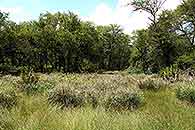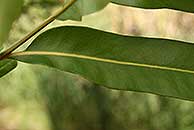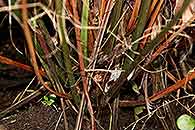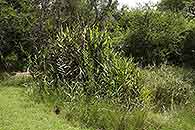Acrostichum aureum L.
Synonyms |
Acrostichum inaequale Willd. |
|---|---|
Common name |
|
Description |
Plants in colonies or large isolated clumps. Rhizome erect to procumbent, massive, c. 6 mm in diameter; rhizome scales hard, 1-4 cm long, dark brown, linear-lanceolate in outline, with thick black median area and margins irregular to lacerate. Fronds erect to arching, tufted, coriaceous, 1.5-3 m long, up to 40 cm wide, with fertile pinnae born towards the apex of the frond, occasionaly forked at the apex. Stipe brown, up to 0.8 m long (up to 1/3 of total frond length), covered with spine-like bladeless pinna bases, shallowly shannelled above. Lamina pinnate with a free conform terminal pinna, roughly lanceolate in outline. Sterile pinnae petiolate, glabrous, linear to oblong-lanceolate in outline, 8-36 x 1-7.5 cm, margin entire to wavy, apex rounded to bluntly pointed, base unequally wedge-shaped, usually directed forward at about 45° from the rachis and facing upwards; midrib prominent on lower surface; venation visible on upper surface with areoles. Fertile pinnae similar in size and shape to sterile pinnae, or sometimes slightly smaller, undersurface entirely covered with sori save for the costa. |
Notes | |
Derivation | aureum: golden, possibly referring to the golden-brown colour of the ripening sporangia in our specimens. |
Habitat | Mostly in coastal mudflats, mangrove forest and reedbeds, in or near estuaries, at inland springs, exposed or lightly shaded, salty marshy valley bottoms in sisal plantations, swampy soil around saline artesian springs. |
Distribution worldwide | pantropical |
Distribution in Africa |
Angola, Benin, Cameroon, Equatorial Guinea (incl. Bioko), Gabon, Ghana, Guinea Bissau, Ivory Coast, Liberia, Mozambique, Nigeria, Senegal, Sierra Leone, South Africa, Tanzania , Zimbabwe. |
Growth form |
Terrestrial. |
Literature |
|






